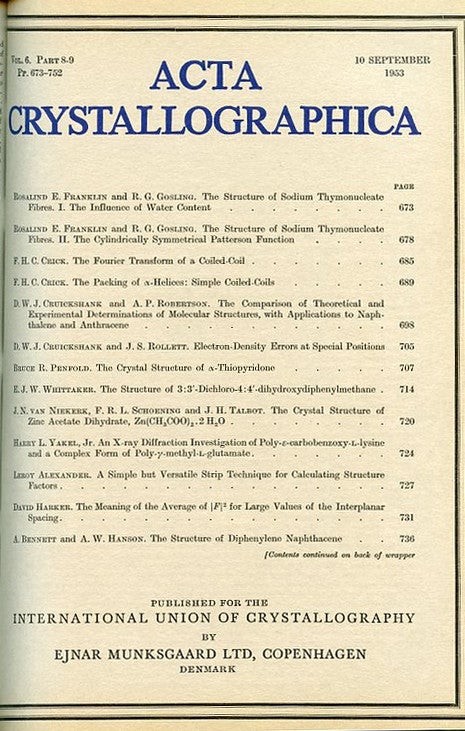The Fourier Transform of a Coiled-Coil, AND The packing of -Helices: Simple Coiled-Coils in Acta Crystallographica, Volume 6, Part 8-9, pp. 678-685 and pp. 689-698
Copenhagen: Ejnar Munksgaard Ltd., 1953. 1st Edition. FIRST EDITION IN PAPER WRAPS OF TWO HISTORIC PAPERS BY FRANCIS CRICK PRESENTING THE FIRST ATTEMPT AT USING SECONDARY-STRUCTURE ELEMENTS TO MODEL THE TERTIARY STRUCTURE OF A PROTEIN – THE ALPHA-HELICAL COILED COIL. “Crick’s molecular model for the coiled coil – entailing left-handed supercoils, heptad repeats and knobs-into-holes packing – has been seen as the definitive account of this structure” (Gruber, Another 50th Anniversary, Trends in Biochemical Science, 12, pp. 679).
“In these papers, [Crick presents] a parametric model for coiled coils of two and three parallel -helices, supercoiled in the opposite direction of the helices and held together by a defined side-chain packing geometry. Particularly noteworthy is Crick's anticipation that packing would be driven by the hydrophobic nature of side-chains and that, therefore, the sequence of coiled coils would show a periodicity of polar and non-polar residues. This occurred at a time when the biophysics of protein folding were unknown and even the exact sequence of a protein still remained to be determined” (Gruber).
“In 1953, Crick and Linus Pauling both proposed models of supercoiled helices… These were the first attempts at modeling the tertiary structure of a protein. Crick emphasized the packing mode of the side-chains ('knobs-into-holes'), which required a periodicity of 7/2 helical turns and a supercoil in the opposite sense of the constituent helices. By contrast, Pauling envisaged a broader set of periodicities and supercoils of both senses” (Gruber). It was Crick’s model, however, that “became canonical and [his] ‘heptad repeat’ [is] essentially synonymous with coiled coils” (ibid).
Crick’s idea derived “from model-building experiments which show that if the helices are distorted systematically in the manner proposed, the side chains of one helix can be made to interlock with the holes between side chains of its neighbor” (Neurath, 903).
In these papers, Crick develops these ideas. In the first, he obtains an expression for and “gives a theory for the Fourier transform of a coiled coil” (ibid). He presents the Fourier transforms for both a continuous coiled-coil, “and for a set of atoms spaced at regular intervals along a coiled-coil” (Crick, 685).
In the second paper, Crick “introduces the first packing scheme for helices using a graphical construction referred to as the knobs into holes model” (Ghelis, 68). He “first described how a simplified view of the surface features of an -helix could be seen to restrict the crossing angle of a close-packed pair of helices. If the side chains are considered as simple knobs and the spaces between the knobs as holes, then if a pair of helices is to brought into extended close contact, a series of the knobs must fit into corresponding hole regions. From the geometry of -helices and simplifying assumptions, he derived crossing angles for both parallel and antiparallel helices that would enable this type of packing” (Frishman, Structural Bioinformatics).
“Crick's initial communication was a one-page letter in Nature providing barely enough detail to show that he had obtained a parametrization of the coiled coil based on a periodicity of 7/2, which allowed the side-chains to interlock systematically… However, the actual equations, or indeed any explicit mention of the 7/2 periodicity and of the handedness of the supercoil it entails, are missing from [that communication]. All these aspects and more were covered in great detail in [these] two back-to-back papers by Crick in Acta Crystallographica… which still represent the main reference point for the field today” (Gruber). Item #530
CONDITION & DETAILS: Copenhagen: Munksgaard Ltd. First edition in original wraps. 4to. (256 x 188mm). Pp. 673-752. Meticulously re-backed at the spine with the original spine label. Pristine condition inside and out. Fine.
Price: $1,750.00

